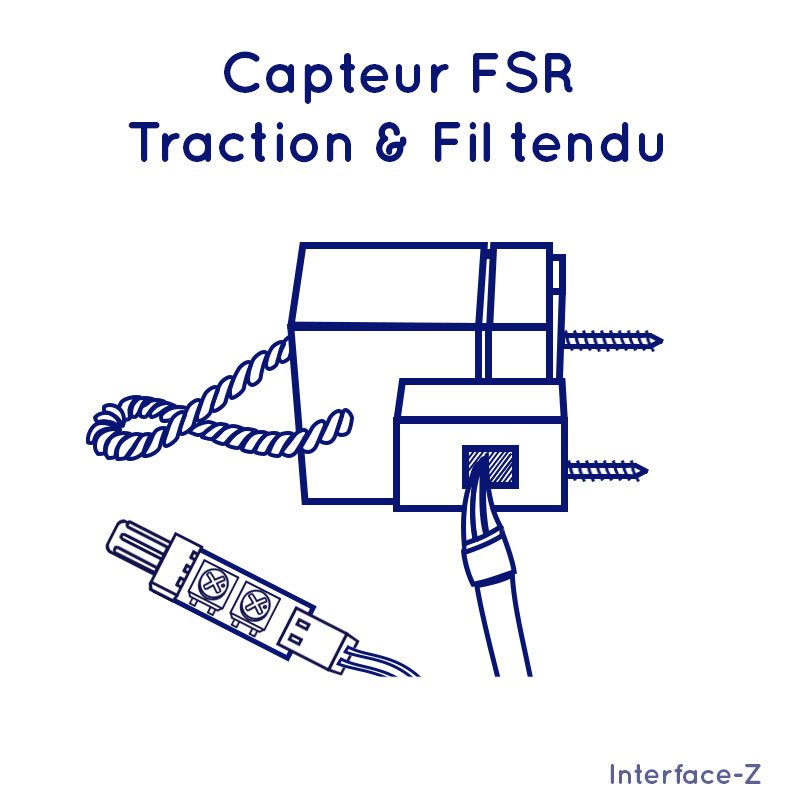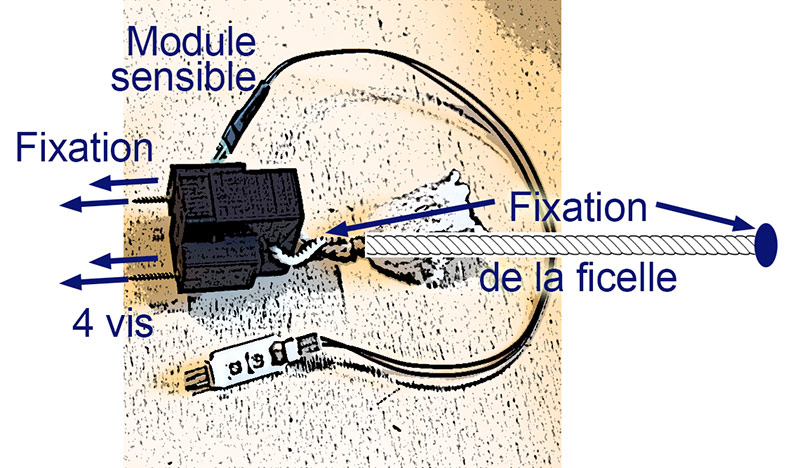









How does one detect that a passerby has touched a stretched or hanging string within a path in an exhibition space ? How does one measure the vibration, pinch, percussion or pull of that same string in a musical device ? The string then becomes a part of the intrument. How does one measure the contact or lack thereof with a string stretched over a rigged corridor in a game, on the way to getting a treasure chest for instance ? How does one detect that a string within a giant spiderweb has been grazed ?
Interface-Z's Traction FSR is an innovation for musicians that create their own electronic instruments, obstacle course game designers or artists that wish to guide their spectators through an interactive route. This force sensor allows one to measure the exercised force of traction applied on a stretched wire or string, or the manipulation of a hanging object. It was imagined with artists, museums and game-rooms in mind. The strings can be stretched horizontally, tilted diagonally or hung vertically.
Thanks to a solid fixture with 3D printed shapes and a dedicated electronic card, this sensor is easy and ready to use. It was thought out for optimal adaptability for any type of interactive application.
Comparison of different stretched wires – spiderweb at Interface-z
A small specific card has been developped for this particular sensor. It allows us to :
Adjust the sensitivity of the sensor, with a potentiometer, so that it's response is adapted to each case ;
Denoise a signal so that its clean and easy to process ;
Stabilize the rest level, meaning the base measure when nothing is happening ;
This rest level changes depending on each device and each string, the sensor is self-adjusting. No matter the context, the rest level should be at half of the maximum value sent by the sensor (around 64 in standard Midi protocol, or 2048 in extended Midi, etc)
One of the main advantages of our sensor is its constant rest level and that is is self-adapting. It will readjust itself regardless of the initial tension on the string. This also means that the string can be re-fastened or re-stretched while the installation is working, for maintenance or esthetic needs, without it impairing the efficiency of the sensor.
To insure a durable and reliable installation, our sensor is equipped with mechanical pieces that encapsulate the sensitive module and make it easy to attach a string or wire. This fastening method garanties optimal stability.
The set of sensitive module + mechanical shapes can easily be detached from the electronic card with a 2 pin connector. Why ?
To avoid breaking the junction of the strings in case one makes an error while manipulating the object.
To ease the installation through a rail or structure if one needs to hide the card behind a board separated from the module and its 3D shapes.
The module is easy to replug onto the card's pins with a simple and practical 2 way connector.

The compatible strings are of varied nature :
The shape meant for fastening the wire has a hole a few millimeters wide. The sensor isn't meant for thick or heavy rope.
Length : from a few centimeters to a few meters. For example we have tested it with a 3mm elastic wire stretched horizontally over 4 meters.
Orientation :
Horizontal mounting, with a fixed point on the otherside of the string on a wall/board/rail/object ;
Tilted diagonally is similar to horizontal mounting. One must just plan un support with an angle to adjust the orientation of the sensor ;
Vertical mounting, with the sensor above, or with a fixed point on the bottom, or with a hanging object. The total weight of the string + object must not be more than 5 kg.
Interactive installations where the spectators graze, pull, or simply make contact with strings, where the audience touches hanging objects, or if they have to move around while avoiding those strings.
The detections activate sounds, modulates lights or changes pictures.
The sensor can be integrated to interactive games or events for children, in obstacle courses where one must not touch the strings, in escape games where one must find a sequence to get to the next puzzle.
For experimenting composers and musicians that perform, or to imagine parcipipatory sound devices, this sensor can be associated with cords to control effects and interactive instruments.
The traction FSR sensor is a multipurpose tool that let's one explore new perspectives in real-time interactivity.
Il n'y a pas d'autres documents disponibles ici pour le moment.
You might also like